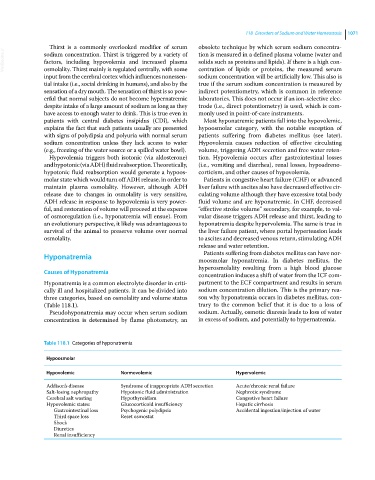Page 1133 - Clinical Small Animal Internal Medicine
P. 1133
118 Disorders of Sodium and Water Homeostasis 1071
Thirst is a commonly overlooked modifier of serum obsolete technique by which serum sodium concentra-
VetBooks.ir sodium concentration. Thirst is triggered by a variety of tion is measured in a defined plasma volume (water and
solids such as proteins and lipids). If there is a high con-
factors, including hypovolemia and increased plasma
osmolality. Thirst mainly is regulated centrally, with some
input from the cerebral cortex which influences nonessen- centration of lipids or proteins, the measured serum
sodium concentration will be artificially low. This also is
tial intake (i.e., social drinking in humans), and also by the true if the serum sodium concentration is measured by
sensation of a dry mouth. The sensation of thirst is so pow- indirect potentiometry, which is common in reference
erful that normal subjects do not become hypernatremic laboratories. This does not occur if an ion‐selective elec-
despite intake of a large amount of sodium as long as they trode (i.e., direct potentiometry) is used, which is com-
have access to enough water to drink. This is true even in monly used in point‐of‐care instruments.
patients with central diabetes insipidus (CDI), which Most hyponatremic patients fall into the hypovolemic,
explains the fact that such patients usually are presented hypoosmolar category, with the notable exception of
with signs of polydipsia and polyuria with normal serum patients suffering from diabetes mellitus (see later).
sodium concentration unless they lack access to water Hypovolemia causes reduction of effective circulating
(e.g., freezing of the water source or a spilled water bowl). volume, triggering ADH secretion and free water reten-
Hypovolemia triggers both isotonic (via aldosterone) tion. Hypovolemia occurs after gastrointestinal losses
and hypotonic (via ADH) fluid reabsorption. Theoretically, (i.e., vomiting and diarrhea), renal losses, hypoadreno-
hypotonic fluid reabsorption would generate a hypoos- corticism, and other causes of hypovolemia.
molar state which would turn off ADH release, in order to Patients in congestive heart failure (CHF) or advanced
maintain plasma osmolality. However, although ADH liver failure with ascites also have decreased effective cir-
release due to changes in osmolality is very sensitive, culating volume although they have excessive total body
ADH release in response to hypovolemia is very power- fluid volume and are hyponatremic. In CHF, decreased
ful, and restoration of volume will proceed at the expense “effective stroke volume” secondary, for example, to val-
of osmoregulation (i.e., hyponatremia will ensue). From vular disease triggers ADH release and thirst, leading to
an evolutionary perspective, it likely was advantageous to hyponatremia despite hypervolemia. The same is true in
survival of the animal to preserve volume over normal the liver failure patient, where portal hypertension leads
osmolality. to ascites and decreased venous return, stimulating ADH
release and water retention.
Patients suffering from diabetes mellitus can have nor-
Hyponatremia moosmolar hyponatremia. In diabetes mellitus, the
hyperosmolality resulting from a high blood glucose
Causes of Hyponatremia concentration induces a shift of water from the ICF com-
Hyponatremia is a common electrolyte disorder in criti- partment to the ECF compartment and results in serum
cally ill and hospitalized patients. It can be divided into sodium concentration dilution. This is the primary rea-
three categories, based on osmolality and volume status son why hyponatremia occurs in diabetes mellitus, con-
(Table 118.1). trary to the common belief that it is due to a loss of
Pseudohyponatremia may occur when serum sodium sodium. Actually, osmotic diuresis leads to loss of water
concentration is determined by flame photometry, an in excess of sodium, and potentially to hypernatremia.
Table 118.1 Categories of hyponatremia
Hypoosmolar
Hypovolemic Normovolemic Hypervolemic
Addison’s disease Syndrome of inappropriate ADH secretion Acute/chronic renal failure
Salt‐losing nephropathy Hypotonic fluid administration Nephrotic syndrome
Cerebral salt wasting Hypothyroidism Congestive heart failure
Hypovolemic states: Glucocorticoid insufficiency Hepatic cirrhosis
Gastrointestinal loss Psychogenic polydipsia Accidental ingestion/injection of water
Third space loss Reset osmostat
Shock
Diuretics
Renal insufficiency

